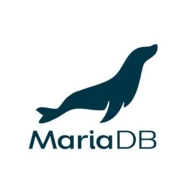

InfluxDB and MariaDB compete in database technology with InfluxDB focusing on time-series data and MariaDB on relational databases. InfluxDB is preferred for time-series performance, while MariaDB is favored for its advanced features.
Features: InfluxDB efficiently manages time-series data, supports high write throughput, and provides downsampling. Its query language is SQL-like, making it accessible. InfluxDB's fast query performance and lightweight nature are beneficial for handling large datasets. In contrast, MariaDB offers robust transaction processing, SQL standard compatibility, and advanced replication. With a powerful community ecosystem, MariaDB supports various plugins and has a user-friendly interface, combining flexibility with strong analytics capabilities.
Room for Improvement: InfluxDB could benefit from expanding its feature set beyond time-series to be more versatile. Integration with more third-party tools could also enhance its usability. Additionally, simplifying complex queries would improve user experience. MariaDB could enhance its documentation for complex configurations. Greater support for time-series data might broaden its applicability. Simplifying advanced replication set-up could make it more accessible for less experienced users.
Ease of Deployment and Customer Service: InfluxDB is known for its simple deployment with minimal setup, making it ideal for swift time-series implementations. Its customer service is efficient for basic user needs. Conversely, MariaDB supports complex configurations and scales well for large enterprises. Its customer service is comprehensive, making it suitable for intricate deployments.
Pricing and ROI: InfluxDB offers competitive pricing that appeals to budget-conscious customers, providing a quick ROI for time-series solutions. MariaDB's pricing may be higher due to its extensive feature set, but provides good ROI through its enhanced functionality and enterprise-level support. While InfluxDB attracts those looking for cost-effective time-series databases, MariaDB's pricing is justified by its robust capabilities.
| Product | Market Share (%) |
|---|---|
| MariaDB | 6.7% |
| InfluxDB | 4.6% |
| Other | 88.7% |


| Company Size | Count |
|---|---|
| Small Business | 4 |
| Midsize Enterprise | 3 |
| Large Enterprise | 6 |
| Company Size | Count |
|---|---|
| Small Business | 27 |
| Midsize Enterprise | 12 |
| Large Enterprise | 25 |
InfluxDB is open-source software that helps developers and enterprises alike to collect, store, process, and visualize time series data and to build next-generation applications. InfluxDB provides monitoring and insight on IoT, application, system, container, and infrastructure quickly and easily without complexities or compromises in scale, speed, or productivity.
InfluxDB has become a popular insight system for unified metrics and events enabling the most demanding SLAs. InfluxDB is used in just about every type of industry across a wide range of use cases, including network monitoring, IoT monitoring, industrial IoT, and infrastructure and application monitoring.
InfluxDB offers its users:
InfluxDB Benefits
There are several benefits to using InfluxDB . Some of the biggest advantages the solution offers include:
Reviews from Real Users
InfluxDB stands out among its competitors for a number of reasons. Two major ones are its flexible integration options and its data aggregation feature.
Shalauddin Ahamad S., a software engineer at a tech services company, notes, “The most valuable features are aggregating the data and the integration with Grafana for monitoring.”
MariaDB is an open source relational database created by the original founders of MySQL. It is considered one of the most popular and trusted database servers throughout the world. MariaDB is a valued component found in most cloud offerings and is the default in many Linux tools. It is also widely used by Wikipedia, WordPress, and Google, among other well-known sites. Maria DB easily melds data into concise information from a vast array of applications, such as banking, online shopping, websites, and more.
MariaDB was originally created to improve MySQL performance. It is the most widely chosen database server due to the solution being super fast, robust, user-friendly, and easily scalable. MariaDB also offers a substantial ecosystem of plugins, storage engines, and numerous other valuable tools that make it very attractive for a significant offering of use cases.
The solution’s newest functionalities include compatibility with Oracle Database and Temporal Data Tables, and advanced clustering with Galera Cluster 4, which make it easier for users to research data history from any point in the past. Additionally, the most recent versions include JSON and GIS features. MariaDB is committed to staying an open source solution.
MariaDB Features
Reviews from Real Users
Faustine C., Engineering Supervisor- Corporate Data Solutions and Services at TZ Telecoms Corporation, shares, “The software provides a lot of information on what is happening inside the database. For most performance parameters it is easy to know if something is not right in the configuration or optimization which helps engineers take remedial fine-tuning measures. For example, if the database is underperforming it is easy to know which performance parameter can be adjusted to handle the workload. It is difficult to troubleshoot database issues if many performance parameters can not be monitored or debugged which is the case with some database management systems. It provides great monitoring of data storage, processing, and performance stability which is really important for real-time data storage and processing. It's a user-friendly product.”
A PeerSpot user who is a Senior Engineer at a tech services company relates, “ The solution's high availability is its most valuable aspect. We have found the product to be stable and the initial setup is pretty simple. I'd rate the solution at a ten out of ten. I'm very happy with it overall. I would recommend the solution to others. It's easy to find details about the product online and to learn about it.”
We monitor all Open Source Databases reviews to prevent fraudulent reviews and keep review quality high. We do not post reviews by company employees or direct competitors. We validate each review for authenticity via cross-reference with LinkedIn, and personal follow-up with the reviewer when necessary.